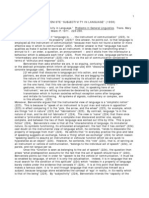Inverted U Theory
Inverted U Theory
Uploaded by
khalil2890Copyright:
Available Formats
Inverted U Theory
Inverted U Theory
Uploaded by
khalil2890Copyright
Available Formats
Share this document
Did you find this document useful?
Is this content inappropriate?
Copyright:
Available Formats
Inverted U Theory
Inverted U Theory
Uploaded by
khalil2890Copyright:
Available Formats
Inverted U theory
The Inverted U theory was developed in 1908 by Yerkes and Dodson and it is atheory of arousal that considers that optimal performance occurs when the performer reaches an optimal level of arousal.
The Inverted U theory seems to fit more accurately withobservations of performancethan the Drive theory. According to the theory performance will improve as arousal increases until it reaches a point where optimum performance is achieved, and arousal is at its optimum level. if arousal increases beyond this point, performance will begin to deteriorate as seen on the image to the right.
1. In many ways this theory fits into the observations from sport performers but in reality is too simplistic and so the theory has to be adapted to answer two questions:Does Inverted U theory apply equally to expert performers and beginners? 2. Does it apply to all sports performances in the same way? In respect to the first question, research explains many reasons why beginners are not able to perform as strong as
experts as levels of arousal increase: A beginner the skill is less groomed and so is not habitual which is similar to Hull and his Drive theory.
Beginners tend to need a greater proportion of attention to the performance of a skill whereas to an expert the skill is so well practiced that it is performed automatically. When the beginner has a high level of arousal the beginner can get distracted and tends not to give the same amount of attention to the skill and so performance deteriorates.
Beginners rely heavily on cues and signals within the environment to perform the right skills and movements in the right situations and at the right moment. As arousal increases their focus on the essential cues and signal declines and so the beginners lose concentration and are unable to react to the unexpected and performance deteriorates Therefore beginners normally perform better with lower levels of arousal than an expert would need, although they still need to reach the optimum level of arousal to ensure that optimal performance is likely to occur.
The optimum level of arousal can also vary in relation to the skill being performed. Performers that are involved in activities that incorporate major muscle groups or in a gross skill such as weightlifting, may benefit from having higher levels of arousal, whereas performers that are involved in activities which incorporate finer skills such as snooker or darts may benefit from lower levels of arousal. As you can see from the diagram below, even though some skills require
higher or lower levels of arousal a performer can still be under- or over-aroused for their particular skill, with a subsequent deterioration in performance
You might also like
- The Rugby Strength Coach Power Template 2.0 - READ ME FIRSTDocument17 pagesThe Rugby Strength Coach Power Template 2.0 - READ ME FIRSTMayank Singh garia100% (1)
- LDR 300 Final Exam: LDR 300 Final Exam Innovative Leadership - UOP StudentsDocument21 pagesLDR 300 Final Exam: LDR 300 Final Exam Innovative Leadership - UOP StudentsUOP StudentsNo ratings yet
- Architecture - February 2022Document34 pagesArchitecture - February 2022ArtdataNo ratings yet
- The 10 New Essentials of Training For Power Athletes PDFDocument19 pagesThe 10 New Essentials of Training For Power Athletes PDFTheo Le Floch-andersen100% (1)
- The Peak Performance Zone: How to get into The Zone and take your performance to the next level.From EverandThe Peak Performance Zone: How to get into The Zone and take your performance to the next level.Rating: 4.5 out of 5 stars4.5/5 (2)
- Coordination DraftDocument11 pagesCoordination Drafteddie_smith24100% (1)
- Foster Partners Structural Engineering BrochureDocument117 pagesFoster Partners Structural Engineering BrochureChristopher Yuwono100% (1)
- Fighting AgeismDocument8 pagesFighting AgeismApple Esteban CalmaNo ratings yet
- Adversity Quotient of NEUST-SIC CoEd FacultyDocument6 pagesAdversity Quotient of NEUST-SIC CoEd FacultyIJELS Research JournalNo ratings yet
- Human Relations ManagementDocument11 pagesHuman Relations ManagementJoackimm LlameraNo ratings yet
- Organizational PoliticsDocument12 pagesOrganizational PoliticsNeil MajumderNo ratings yet
- 01 Mission and VissionDocument14 pages01 Mission and VissionOmkar RanadeNo ratings yet
- Nursepreneurs Essay by J. BacarisasDocument17 pagesNursepreneurs Essay by J. BacarisasCris GalendezNo ratings yet
- LeadershipDocument24 pagesLeadershipJishu Twaddler D'CruxNo ratings yet
- Chaos TheoryDocument7 pagesChaos TheoryUJJAL SAHUNo ratings yet
- PERSONALITY POWERPOINT PRESENTATION by Teacher MajoyDocument23 pagesPERSONALITY POWERPOINT PRESENTATION by Teacher MajoyMarie Joy L. AlingogNo ratings yet
- Day 4 - Emotional Intelligence Self-EvaluationDocument2 pagesDay 4 - Emotional Intelligence Self-EvaluationSanyam AgarwalNo ratings yet
- Johari WindowDocument16 pagesJohari WindowNiharika DarukaNo ratings yet
- Conflict ResolutionDocument17 pagesConflict ResolutionDiana Marie100% (1)
- Leadership NSTPDocument53 pagesLeadership NSTPYassi CurtisNo ratings yet
- Characteristics of An Effective LeaderDocument9 pagesCharacteristics of An Effective LeaderNurul Azrianti AzizNo ratings yet
- Team WorkDocument9 pagesTeam Workabhdon100% (1)
- Purpose in LifeDocument1 pagePurpose in Lifeaashish95100% (1)
- Ethical DilemmaDocument19 pagesEthical DilemmaDeepak MeenaNo ratings yet
- Adversity QuotientDocument5 pagesAdversity QuotientEliel Olivere100% (2)
- Arousal Theory: Relationship To PerformanceDocument18 pagesArousal Theory: Relationship To PerformanceJan Jan100% (1)
- L.O.3 - Arousal (Leaflet)Document6 pagesL.O.3 - Arousal (Leaflet)OliviaMcCarthy6No ratings yet
- Arousal 1Document17 pagesArousal 1api-240297268No ratings yet
- Training Strategies For Concentration: Growth To Peak Performance, 5 Edition. Boston: Mcgraw Hill, 404-422Document25 pagesTraining Strategies For Concentration: Growth To Peak Performance, 5 Edition. Boston: Mcgraw Hill, 404-422RafaelAlejandroCamachoOrtega100% (1)
- Training Strategies For ConcentrationDocument25 pagesTraining Strategies For Concentrationkabshiel100% (1)
- Stress and Arousal Sport ScienceDocument7 pagesStress and Arousal Sport Sciencetnbv5gyg2yNo ratings yet
- U Hypothesis Arousal for PerformanceDocument3 pagesU Hypothesis Arousal for PerformancevampystringNo ratings yet
- Section 3 - 4 - Arousal and AttentionDocument31 pagesSection 3 - 4 - Arousal and Attentionjoselutp91No ratings yet
- 14 Mark Questions For Sport Psychology: Arousal TheoriesDocument10 pages14 Mark Questions For Sport Psychology: Arousal Theoriesammar_ahmed_19No ratings yet
- En Mean Value Theorem by SlidesgoDocument5 pagesEn Mean Value Theorem by SlidesgoJessycaNo ratings yet
- Arousal TheoryDocument22 pagesArousal TheoryCC TANo ratings yet
- A2 Pe Coursework WeaknessesDocument5 pagesA2 Pe Coursework Weaknessespenebef0kyh3100% (2)
- Practice Makes Perfect ESSAYDocument2 pagesPractice Makes Perfect ESSAYpeachyskizNo ratings yet
- Need of Psychology in The Field of Physical EducationDocument3 pagesNeed of Psychology in The Field of Physical EducationBishal KhaidemNo ratings yet
- Yerkes Dodsdon's LawDocument3 pagesYerkes Dodsdon's LawSowoleNo ratings yet
- Updated Sports PsychologyDocument65 pagesUpdated Sports Psychologyapi-642709499No ratings yet
- A Level P.E CourseworkDocument7 pagesA Level P.E Courseworkafiwftfbu100% (2)
- The Importance of Purposeful and Deliberate Practice in SuccessDocument7 pagesThe Importance of Purposeful and Deliberate Practice in SuccessChi Lê Đặng Khuê0% (1)
- Basketball Training For Speed Agility and QuicknessDocument6 pagesBasketball Training For Speed Agility and QuicknessAlbert StoneNo ratings yet
- ArousalDocument5 pagesArousalllewisbtecsportNo ratings yet
- Sports Psychology Assignment 2Document2 pagesSports Psychology Assignment 2George YarwoodNo ratings yet
- Week 5 Module Grade 9Document7 pagesWeek 5 Module Grade 9Levy John SabulaoNo ratings yet
- HMS Term 1 ModuleDocument11 pagesHMS Term 1 ModuleSirupyEwe GamerNo ratings yet
- Chapter 16Document13 pagesChapter 16Rosalina TabasaNo ratings yet
- Nick Winkelman Coaching ScienceDocument15 pagesNick Winkelman Coaching ScienceDiego LacerdaNo ratings yet
- Hit HardDocument88 pagesHit HardIan100% (1)
- Theories of MotivationDocument3 pagesTheories of MotivationineedsheetzNo ratings yet
- LESSON-1-WARMUP-AND-STRETCHINGDocument30 pagesLESSON-1-WARMUP-AND-STRETCHINGangelienelisondraNo ratings yet
- Thesis Statement For Physical FitnessDocument4 pagesThesis Statement For Physical Fitnessynwtcpwff100% (2)
- Level 4 - Chapter 11 - Mental Training and PsychologyDocument33 pagesLevel 4 - Chapter 11 - Mental Training and PsychologyyangNo ratings yet
- Using The Force-Velocity Curve To Build Better Athletes - Elite FTS PDFDocument8 pagesUsing The Force-Velocity Curve To Build Better Athletes - Elite FTS PDFok okNo ratings yet
- Anxiety Affects Sports Performance. Autor Shobha S.Document22 pagesAnxiety Affects Sports Performance. Autor Shobha S.vaishnavhasani2No ratings yet
- Principles of TrainingDocument17 pagesPrinciples of Trainingribeiro.aikido4736100% (1)
- Acquisition of Skill: How Does The Affect Performance?Document22 pagesAcquisition of Skill: How Does The Affect Performance?janaaidaas1996No ratings yet
- 8 Week Speed Development by Gray CookDocument23 pages8 Week Speed Development by Gray Cookfnandow4l100% (4)
- 10 Thousand Hour MythDocument3 pages10 Thousand Hour MythAnonymous 2HzrnXCNo ratings yet
- Vabb PDFDocument46 pagesVabb PDFTeam KaijastiNo ratings yet
- Gender EqualityDocument5 pagesGender Equalitynatassayannakouli100% (1)
- Faith Heminger Critical Self ReflectionDocument5 pagesFaith Heminger Critical Self Reflectionapi-385782224No ratings yet
- Republic vs. OrtigasDocument2 pagesRepublic vs. OrtigasKarla Marxielle GulanesNo ratings yet
- People of The Philippines Vs Edwin Concepcion Y Jacinto, Et. AlDocument4 pagesPeople of The Philippines Vs Edwin Concepcion Y Jacinto, Et. AlLacab ShierlyNo ratings yet
- TEAM 11 - MOOT MEMORIAL (Petitioner) - A4 SizeDocument18 pagesTEAM 11 - MOOT MEMORIAL (Petitioner) - A4 SizeVINODKUMARNo ratings yet
- An ISO 9001:2008 Certified Quality Institute (Recognized by Govt. of NCT of Delhi, Affiliated To GGS Indraprastha University, Delhi)Document3 pagesAn ISO 9001:2008 Certified Quality Institute (Recognized by Govt. of NCT of Delhi, Affiliated To GGS Indraprastha University, Delhi)aditya guptaNo ratings yet
- Manuscript - Template JPHRESDocument11 pagesManuscript - Template JPHRESmeivita dewiNo ratings yet
- 10.library Space Assessment - User Learning Behaviors in The LibraryDocument15 pages10.library Space Assessment - User Learning Behaviors in The LibraryMarijanaMarkovicNo ratings yet
- Chapter 5 B2B Electronic Commerce True/FalseDocument7 pagesChapter 5 B2B Electronic Commerce True/FalseNabilah Musri98No ratings yet
- Ateneo de Davao University Senior High SchoolDocument12 pagesAteneo de Davao University Senior High SchoolShaira CogollodoNo ratings yet
- Containing Byzantine Failures With Control Zones: Disadvantages of Existing SystemDocument4 pagesContaining Byzantine Failures With Control Zones: Disadvantages of Existing SystemThe Futura LabsNo ratings yet
- Language TransferDocument22 pagesLanguage TransferLacey CondeNo ratings yet
- Computer 9: WEB DESIGN: Cascading Style SheetDocument8 pagesComputer 9: WEB DESIGN: Cascading Style Sheetcoalie galaxyNo ratings yet
- Dr. Verghese Kurien: Early YearsDocument8 pagesDr. Verghese Kurien: Early YearsChandan K CNo ratings yet
- Land Law: Assignment ofDocument17 pagesLand Law: Assignment ofR GamingNo ratings yet
- Chandni Merena JoseDocument4 pagesChandni Merena JoseAnisha VermaNo ratings yet
- Lloyds Thorough Examination and Inspection of Mobile Cranes and Crawler CranesDocument134 pagesLloyds Thorough Examination and Inspection of Mobile Cranes and Crawler CranesChiheb Kaaniche100% (1)
- Demonstrate An Understanding of The Role of The Australian Professional Standards For Teachers in Identifying Professional Learning NeedsDocument2 pagesDemonstrate An Understanding of The Role of The Australian Professional Standards For Teachers in Identifying Professional Learning Needsapi-427782046No ratings yet
- 138Document12 pages138Steve LyjuNo ratings yet
- Harambe Cameroon - Inauguration CompendiumDocument10 pagesHarambe Cameroon - Inauguration CompendiumHarambe CameroonNo ratings yet
- Bridge Changes China's ImageDocument2 pagesBridge Changes China's ImageIndra MishraNo ratings yet
- TFS Security SolutionsDocument8 pagesTFS Security SolutionsPrasad RaoNo ratings yet
- Mastering-Ibt TOEFL Ak1Document112 pagesMastering-Ibt TOEFL Ak1bugabooo100% (4)
- Research ProposalDocument15 pagesResearch Proposalmohammed salmanNo ratings yet
- Émile Benveniste "Subjectivity in Language" (1958) : Richard L. W. Clarke LITS3304 Notes 02BDocument5 pagesÉmile Benveniste "Subjectivity in Language" (1958) : Richard L. W. Clarke LITS3304 Notes 02Bholt.parker4072No ratings yet
- Lesson Plan For ClothingDocument3 pagesLesson Plan For ClothingYee Mon AungNo ratings yet
























































































